|
|
|
|
There are photographs and videos of survivor testimonies of the 1918 Spanish flu. It was taught in U.S. history courses. And yet it seemed like the world was completely blindsided by the coronavirus pandemic. Why was the threat downplayed? Why didn’t people understand the risks?
Sean Donahue, a Ph.D. candidate in philosophy at the University of Southern California, Dornsife College of Letters, Arts and Sciences, explains why, once living memory of a disaster fades, it becomes so difficult to grasp the risk of another one happening. For reasons both psychological and technological, memorializing the current pandemic will be particularly challenging.
Also today:
|
Nick Lehr
Arts + Culture Editor
|

|
|
Top story
|

It takes roughly 90 years for the living memory of an event to disappear.
Anurag Papolu/The Conversation via AP Images
Sean Donahue, University of Southern California – Dornsife College of Letters, Arts and Sciences
A global pandemic might be at the forefront of everyone's minds. But we can't assume that future threats will get the attention they deserve from people living in an information-saturated world.
|
Politics + Society
|
-
Michael J. Socolow, University of Maine
Reporters are trained to advance a story and report what is new. But that approach can end up shortchanging news consumers, who need greater context and persistent focus on an ongoing story.
|
|
Health + Medicine
|
-
Claudia Finkelstein, Michigan State University
Without clear guidelines from states or the feds on how to stay safe after reopening, it's hard to know what to do. A doctor suggests things to consider in a park, at the beach and the pool.
-
Michelle Flaum Hall, Xavier University; Scott E. Hall, University of Dayton
COVID-19 patients are spending weeks in intensive care units, isolated and alone, knowing they have a disease that doctors don't fully understand. It's a recipe for post-traumatic stress disorder.
-
Simon F. Haeder, Pennsylvania State University
Studies repeatedly have shown that health care in general and the high cost of drugs in particular are among the top concerns of US voters. But with coronavirus, the issue may fade from prominence.
-
Richard Gunderman, Indiana University
Doctors hear many of the same basic questions about sex from their patients.
|
|
Science + Technology
|
-
Piyush K. Jain, University of Florida
Testing for coronavirus has been a fiasco in the US. But now companies are developing super fast tests, including ones that might eventually be as simple as at home pregnancy tests.
-
Alexander (Sasha) Poltorak, Tufts University
We blame the coronavirus for the thousands of deaths, but it is actually a hyperactive immune reaction that is the cause of death. An immunologist explains.
-
Iain Boyd, University of Colorado Boulder
An update of 50-year-old regulations has kickstarted research into the next generation of rockets. Powered by nuclear fission, these new systems could be the key to faster, safer exploration of space.
-
Rebecca Spencer, University of Massachusetts Amherst
Research shows napping helps young children learn, as well as enhancing their emotional well-being.
|
|
Education
|
-
Robert S Clagett, Colorado College
The COVID-19 pandemic has many students thinking about forgoing a year of college. A gap year specialist says many benefits flow from taking the academic break.
|
|
Ethics + Religion
|
-
Christiane Gruber, University of Michigan
From magic bowls to holy shirts, Muslim cultures used various devices to protect the user from harm starting in the 11th century. Many of these objects were beautifully designed, too.
|
|
Most read on site
|
-
Jeremy Howard, University of San Francisco
Recommendations around mask usage are confusing. The science isn't. Evidence shows that masks are extremely effective to slow the coronavirus and may be the best tool available right now to fight it.
-
John Cook, George Mason University; Sander van der Linden, University of Cambridge; Stephan Lewandowsky, University of Bristol; Ullrich Ecker, University of Western Australia
Conspiracy theories about COVID-19, such as those advanced in the video 'Plandemic,' tend to pull from the same playbook. Recognizing that can help keep you from falling for this kind of thinking.
-
Ryan Malosh, University of Michigan
The US is slowly reopening, but the messages from governments are confusing. An expert offers guidance on many people's first priority – connecting with loved ones.
|
|
| |
| |
| |
| |
| |
| |
|
|
|
|
|
|
|